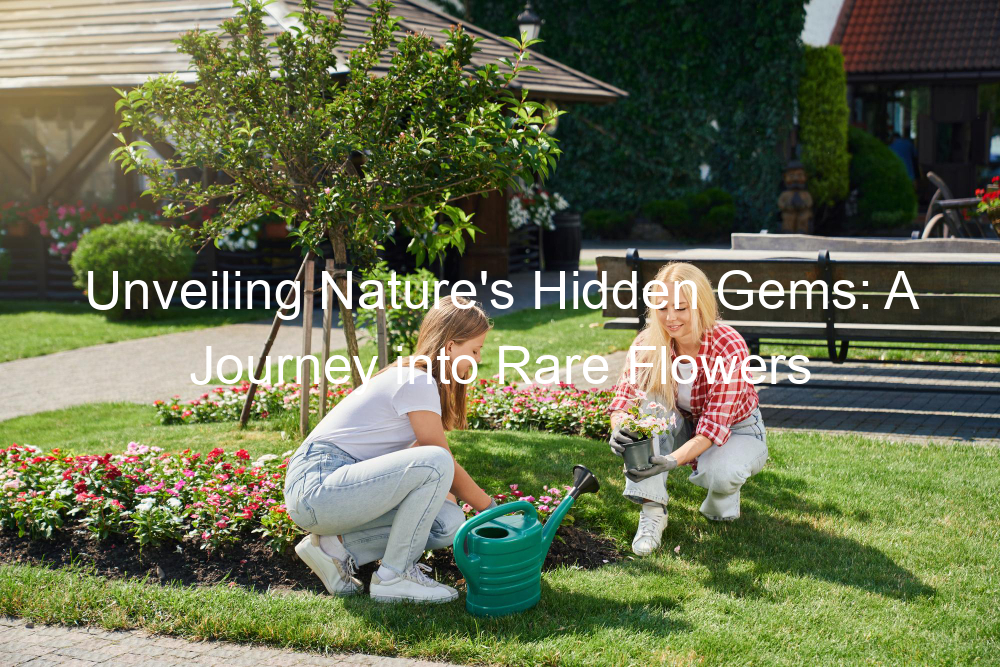Introduction to Rare Flowers Exploration
Flowers are one of nature’s most beautiful creations. They add color, fragrance, and beauty to our world. While we are familiar with many common flowers like roses, tulips, and sunflowers, there are countless rare and unique flowers out there waiting to be discovered. This blog post will introduce you to the exciting world of rare flowers exploration.
-
- Understanding the concept of Rare Flowers
Rare flowers are those that are not commonly found. They might be rare because they only grow in specific conditions or locations, or because they are endangered. Some rare flowers are so unique that they only bloom once a year or even once in a lifetime! Exploring these rare flowers is like going on a treasure hunt, as each one is a precious gem of nature.
-
- The importance of exploring Unique Flowers
Exploring unique flowers is essential for several reasons. Firstly, it helps us appreciate the diversity and beauty of nature. Each unique flower has its own shape, color, and fragrance, which adds to the richness of our natural world. Secondly, studying unique flowers can help scientists learn more about plant biology and ecology. This knowledge can be used to conserve endangered species and protect our environment. Lastly, exploring unique flowers can be a fun and rewarding hobby. It gives us a chance to get outdoors, exercise, and learn something new.
In the following sections, we will dig deeper into the world of rare flowers, exploring their unique characteristics, how to find them, and how to preserve them for future generations. So, let’s embark on this exciting journey of discovery together!
Uncommon Flowers: A World of Blooming Marvels
Uncommon flowers, with their unique shapes, vibrant colors, and captivating fragrances, are true marvels of nature. They add a touch of magic to our world, making it a more beautiful and fascinating place. In this section, we will dig into the world of exotic flower species and explore their intriguing characteristics and habitats.
Exotic Flower Species: A Closer Look
Exotic flowers are not your everyday garden variety. They are often found in remote parts of the world, thriving in unique environments and displaying characteristics that set them apart from more common species. Let’s take a closer look at these floral wonders.
-
- Identifying Exotic Flower Species
Identifying exotic flower species can be a thrilling adventure. These flowers often have unique features that distinguish them from others. For instance, the Corpse Flower, found in the rainforests of Sumatra, is known for its enormous size and pungent odor. The Ghost Orchid, native to Florida, is a rare and elusive species that blooms only under specific conditions.
-
- Understanding the Habitat of Exotic Flowers
Exotic flowers thrive in a variety of habitats, each with its unique set of conditions. The Venus Flytrap, for example, is native to the boggy regions of North and South Carolina, where it has adapted to thrive in poor soil by catching and digesting insects. On the other hand, the Snowdonia Hawkweed, a rare flower native to Wales, grows only on the rocky slopes of Snowdonia National Park.
Understanding the habitats of these flowers is crucial as it provides insights into their survival strategies and the unique adaptations they have developed to thrive in their environments.
| Flower | Habitat | Unique Feature |
|---|---|---|
| Corpse Flower | Rainforests of Sumatra | Enormous size and pungent odor |
| Ghost Orchid | Florida | Blooms only under specific conditions |
| Venus Flytrap | Boggy regions of North and South Carolina | Catches and digests insects |
| Snowdonia Hawkweed | Snowdonia National Park, Wales | Grows only on rocky slopes |
As we continue our journey into the world of uncommon flowers, we will discover more about their unique characteristics, their habitats, and the role they play in their ecosystems. Stay tuned for more blooming marvels!
Blooming Rare Flowers: A Sight to Behold
When it comes to the world of flowers, there are some truly unique and rare blooms that are a sight to behold. These flowers, with their distinctive characteristics and geographical distribution, are a testament to the diversity and beauty of nature. Let’s delve into the fascinating world of blooming rare flowers.
-
Characteristics of Blooming Rare Flowers
Each rare flower has its own unique set of characteristics that sets it apart from the rest. From the mesmerizing color patterns to the intricate petal designs, these flowers are truly one-of-a-kind. For instance, the Corpse Flower, also known as Amorphophallus titanum, is known for its enormous size and peculiar smell. It is one of the largest and rarest flowering structures in the world. Another example is the Ghost Orchid, which is famous for its elusive nature and ghostly appearance.
These flowers not only look different but also have unique blooming cycles. Some bloom only once in a decade, while others bloom at night and wilt by morning. The characteristics of these rare flowers are as diverse as they are fascinating.
-
Geographical Distribution of Blooming Rare Flowers
Rare flowers can be found in various parts of the world, often in remote and unexplored regions. The geographical distribution of these flowers is influenced by factors such as climate, soil type, and altitude.
For instance, the Middlemist Red, considered one of the rarest flowers in the world, is found only in New Zealand and London. The Jade Vine, with its claw-shaped flowers, is native to the tropical rainforests of the Philippines. The Parrot’s Beak, known for its vibrant orange flowers that resemble a parrot’s beak, is native to the Canary Islands but is now almost extinct in the wild.
These flowers, with their unique characteristics and geographical distribution, add to the rich tapestry of biodiversity on our planet.
Unique Floral Species: Discovering the Undiscovered
There’s a whole world of unique and undiscovered floral species waiting to be explored. These flowers, with their distinct shapes, colors, and fragrances, are a testament to the diversity and beauty of nature. Let’s embark on a journey to discover these hidden gems of the floral kingdom.
Exploring Unique Blooms: A Journey into the Unknown
Exploring unique blooms is like stepping into an unknown world. It’s a journey filled with excitement, curiosity, and a sense of wonder. But how do we go about this exploration? And what challenges might we face? Let’s delve into these questions.
-
- Methods of exploring Unique Blooms
Exploring unique blooms involves a combination of fieldwork and laboratory analysis. Fieldwork includes identifying potential locations, observing the flowers in their natural habitat, and collecting samples. Laboratory analysis involves studying the physical characteristics of the flowers, their genetic makeup, and their ecological relationships.
One popular method is the use of Floral Recognition Technology, a tool that uses artificial intelligence to identify and catalog unique blooms. This technology has revolutionized the way we explore and understand the world of flowers.
-
- Challenges faced during the exploration of Unique Blooms
Exploring unique blooms is not without its challenges. Some of these flowers grow in remote or inaccessible locations, making fieldwork difficult. Additionally, the identification and classification of unique blooms can be complex due to their diverse characteristics.
Another challenge is the threat of habitat loss. Many unique blooms are endangered due to deforestation, climate change, and other environmental threats. This makes their exploration and conservation all the more important.
To sum up, exploring unique blooms is a journey of discovery that brings us closer to the wonders of nature. Despite the challenges, it’s a journey worth undertaking for the sheer joy of uncovering the undiscovered.
Rare and Unique Flowers: A Comparative Study
These are the nature’s way of adding color, beauty, and diversity to our world. Among them, rare and unique flowers stand out with their distinctive features and fascinating stories. Moreover, we will dig into a comparative study of these two categories of flowers, highlighting their similarities and differences.
-
- Similarities between Rare and Unique Flowers
Rare and unique flowers share several similarities. Both categories include species that are not commonly found in most parts of the world. They often grow in specific geographical areas or under certain environmental conditions. For instance, the Corpse Flower, a rare flower, and the Ghost Orchid, a unique flower, both thrive in highly specific and somewhat harsh conditions.
Another similarity is their role in attracting specific pollinators. Rare and unique flowers often have distinct shapes, colors, and scents that attract certain species of insects or birds. For instance, the Titan Arum, a rare flower, emits a strong odor to attract carrion beetles, while the unique Bee Orchid mimics the appearance of a female bee to attract male bees for pollination.
-
- Differences between Rare and Unique Flowers
Despite their similarities, rare and unique flowers also have notable differences. The rarity of a flower is often determined by its scarcity in nature. Rare flowers, like the Jade Vine or the Parrot’s Beak, are few in number due to factors such as habitat loss, climate change, or over-collection. They may be on the brink of extinction and are often protected by conservation laws.
On the other hand, unique flowers are characterized by their unusual features that set them apart from other species. They may not necessarily be rare or endangered. For instance, the Venus Flytrap is a unique flower because of its carnivorous nature, but it is not considered rare as it can be cultivated in various parts of the world.
To sum up, while rare and unique flowers share some similarities, they are distinguished by their abundance or scarcity in nature and their distinctive characteristics. The study of these flowers not only enriches our understanding of biodiversity but also underscores the importance of conservation efforts.
Discovering Rare Flowers: A Step-by-Step Guide
Embarking on a journey to discover rare flowers is an exciting adventure. However, before you set off, there are a few essential steps you need to take. This guide will walk you through the process of preparing for your exploration.
Preparation for Discovering Rare Flowers
Preparation is key to a successful exploration. It involves two main steps: researching about rare flowers and gathering the necessary equipment.
-
- Researching about Rare Flowers
Before setting off on your exploration, it’s crucial to do some research. Learn about the different types of rare flowers, where they are typically found, and what they look like. This will help you identify them when you come across them in the wild.
There are many resources available to help with your research. Books, online articles, and documentaries can provide a wealth of information. You can also speak to experts in the field, such as botanists and horticulturists, who can provide valuable insights.
-
- Gathering necessary equipment for the exploration
Once you’ve done your research, the next step is to gather the equipment you’ll need for your exploration. This may include a field guide to help identify flowers, a camera to document your findings, and a notebook to jot down important details.
Other useful items might include a magnifying glass for close-up examination of flowers, a GPS device to help navigate unfamiliar terrain, and a first aid kit for any unexpected injuries. Remember, it’s better to be over-prepared than under-prepared.
With your research done and your equipment gathered, you’re now ready to embark on your journey to discover rare flowers. The next step is the exploration itself, which we will discuss in the next section.
During the Exploration
Once you’re out in the field, the real adventure begins. This phase of the journey involves two crucial steps: identifying rare flowers and documenting your findings. Let’s delve into each of these steps in detail.
- Identifying Rare Flowers
Identifying rare flowers is like solving a fascinating puzzle. It requires a keen eye, a bit of knowledge, and lots of patience. Here’s how to do it:
First, look for unique characteristics. Rare flowers often have unusual shapes, colors, or patterns. For instance, the Ghost Orchid, one of the rarest flowers in the world, is known for its ghost-like appearance. It’s white, almost translucent, and has a unique shape that resembles a dancing ghost.
Second, use a field guide. A field guide is a book or an app that helps identify different species of flowers. It provides pictures and descriptions of various flowers, which can be a great help in identifying rare ones.
Keep in mind, identifying rare flowers can be challenging, but it’s also incredibly rewarding. It’s like finding a hidden treasure in a vast forest.
- Documenting the Findings
Once you’ve identified a rare flower, it’s important to document your findings. This involves taking pictures, writing descriptions, and noting the location.
When taking pictures, try to capture the flower from different angles. This will help others identify the flower later. Also, take a picture of the entire plant, including the leaves and stem, as these can also help in identification.
Writing a description is equally important. Describe the flower’s color, shape, size, and any unique features. Also, note the flower’s habitat and the time of year you found it. This information can be crucial for scientists studying these rare species.
Finally, note the location where you found the flower. This can help others find the flower in the future and can contribute to scientific research.
It’s a chance to connect with nature, learn about different species, and contribute to the understanding of our planet’s biodiversity.
Discovering Rare Flowers: A Step-by-Step Guide
Post-Exploration
After the thrill of the hunt, the real work begins. It’s time to dive into the post-exploration phase. This stage involves two critical steps: analyzing the findings and sharing the discoveries with the world.
-
- Analyzing the Findings
Once we’ve returned from our exploration, we need to carefully examine the rare flowers we’ve discovered. This analysis involves studying the physical characteristics of the flowers, such as their color, size, and shape. We also look at their habitat and growth patterns.
Let’s say we found a flower that’s bright blue, about 2 inches in diameter, and grows in clusters. We’d note all these details down. Then, we’d compare our findings with existing records of rare flowers. This helps us determine if we’ve discovered a completely new species or a variant of an existing one.
-
- Sharing the Discoveries with the World
After analyzing our findings, it’s time to share our discoveries with the world. This can be done through various channels. We could publish a paper in a scientific journal, present at a botanical conference, or even post on social media for the public to enjoy.
Sharing our discoveries is not just about gaining recognition. It’s also about contributing to the world’s knowledge of rare flowers. Each new discovery brings us one step closer to understanding the amazing diversity of our planet’s flora.
In summary, the post-exploration phase is just as important as the exploration itself. It’s where we make sense of our findings and share our discoveries with the world. So, the next time you go on a flower exploration, remember to take the time to analyze your findings and share your discoveries. You never know, you might just discover the next big thing in the world of rare flowers!
Conclusion: The Joy of Discovering Rare Flowers
As we come to the end of our journey, it’s time to reflect on the joy and wonder that discovering rare flowers brings. These unique blooms not only add color and beauty to our world, but also have a significant impact on it.
-
- Reflection on the Journey of Rare Flowers Exploration
Exploring the world of rare flowers has been an incredible journey. From the lush, tropical rainforests to the arid deserts, we’ve discovered a myriad of unique species that have captivated our hearts and minds. These flowers, each with their own unique characteristics and adaptations, have shown us the amazing diversity of nature. The thrill of discovering a new species, the joy of learning about its unique features, and the satisfaction of understanding its role in the ecosystem, all contribute to the joy of this exploration.
-
- The Impact of Discovering Unique Flowers on the World
Discovering unique flowers has a profound impact on the world. These discoveries can lead to advancements in various fields. For instance, in medicine, rare flowers have been found to contain compounds that can be used to develop new drugs. In the field of ecology, the discovery of new species can provide insights into environmental changes and help in conservation efforts. Moreover, these unique blooms add to the beauty of our world, inspiring artists, poets, and even ordinary people with their exquisite charm.
To sum up, the exploration and discovery of rare flowers is a journey filled with joy, wonder, and learning. It not only enriches our understanding of the natural world but also has the potential to contribute significantly to various fields. So, let’s continue to explore, discover, and cherish these unique floral marvels!






